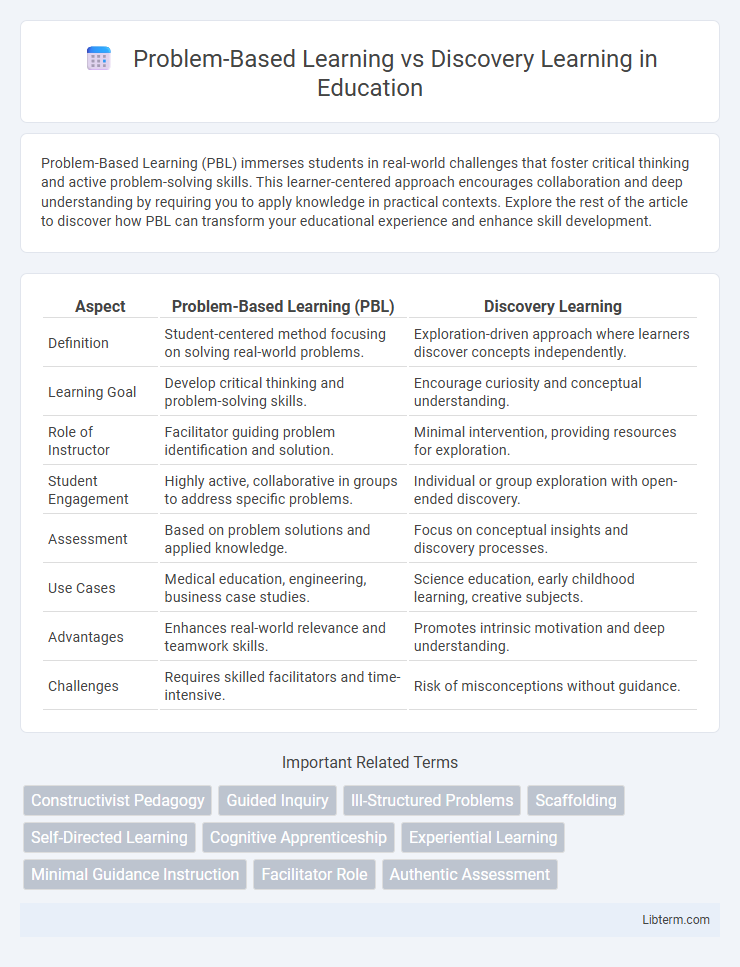Problem-Based Learning (PBL) immerses students in real-world challenges that foster critical thinking and active problem-solving skills. This learner-centered approach encourages collaboration and deep understanding by requiring you to apply knowledge in practical contexts. Explore the rest of the article to discover how PBL can transform your educational experience and enhance skill development.
Table of Comparison
| Aspect | Problem-Based Learning (PBL) | Discovery Learning |
|---|---|---|
| Definition | Student-centered method focusing on solving real-world problems. | Exploration-driven approach where learners discover concepts independently. |
| Learning Goal | Develop critical thinking and problem-solving skills. | Encourage curiosity and conceptual understanding. |
| Role of Instructor | Facilitator guiding problem identification and solution. | Minimal intervention, providing resources for exploration. |
| Student Engagement | Highly active, collaborative in groups to address specific problems. | Individual or group exploration with open-ended discovery. |
| Assessment | Based on problem solutions and applied knowledge. | Focus on conceptual insights and discovery processes. |
| Use Cases | Medical education, engineering, business case studies. | Science education, early childhood learning, creative subjects. |
| Advantages | Enhances real-world relevance and teamwork skills. | Promotes intrinsic motivation and deep understanding. |
| Challenges | Requires skilled facilitators and time-intensive. | Risk of misconceptions without guidance. |
Introduction to Problem-Based Learning and Discovery Learning
Problem-Based Learning (PBL) centers on student engagement through real-world problem-solving, encouraging collaboration and critical thinking to develop practical knowledge. Discovery Learning emphasizes exploration and experimentation, allowing learners to construct understanding independently by interacting with materials and concepts. Both methods promote active learning but differ in structure, with PBL guided by specific problems while Discovery Learning fosters self-directed inquiry.
Defining Problem-Based Learning: Core Principles
Problem-Based Learning (PBL) centers on student-driven inquiry where learners collaboratively solve real-world problems, fostering critical thinking and knowledge application. Core principles include presenting complex, authentic problems without predetermined solutions, promoting self-directed learning, and emphasizing group collaboration to construct understanding. This approach connects theory to practice by engaging students in reflective problem-solving processes that develop transferable skills.
Understanding Discovery Learning: Fundamental Concepts
Discovery Learning emphasizes active exploration and encourages students to construct knowledge through hands-on experiences and self-guided inquiry. Rooted in constructivist theories, it prioritizes student autonomy, enabling learners to formulate hypotheses, test ideas, and draw conclusions independently. This approach fosters critical thinking, retention, and deeper understanding by engaging learners in meaningful problem-solving activities without direct instruction.
Historical Evolution of Both Learning Approaches
Problem-Based Learning (PBL) originated in the 1960s at McMaster University, emphasizing student-centered inquiry to solve real-world problems, reflecting shifts in cognitive and constructivist theories. Discovery Learning, rooted in the early 20th century with contributions from Jean Piaget and Jerome Bruner, focuses on learners actively exploring and constructing knowledge through guided discovery. Both approaches evolved to challenge traditional rote learning, integrating active engagement and critical thinking principles in educational reform during the late 20th century.
Key Differences Between Problem-Based and Discovery Learning
Problem-Based Learning centers on collaborative problem-solving with structured guidance, emphasizing real-world application and critical thinking, while Discovery Learning encourages individual exploration and self-directed inquiry to foster understanding through experience. In Problem-Based Learning, instructors play an active role in facilitating and scaffolding the learning process, contrasting with the minimal intervention typical in Discovery Learning. Assessment in Problem-Based Learning is often based on solution effectiveness and reasoning, whereas Discovery Learning evaluates the learners' ability to generate insights and adapt through exploration.
Advantages of Problem-Based Learning in Education
Problem-Based Learning (PBL) enhances critical thinking by engaging students in real-world problems that require collaborative investigation and practical solutions. It promotes deeper understanding and retention of knowledge through active learning and continuous feedback from instructors and peers. PBL also improves communication and teamwork skills, preparing students for complex professional environments.
Strengths of Discovery Learning for Student Engagement
Discovery Learning fosters active student engagement by encouraging exploration and hands-on problem-solving, which enhances critical thinking and retention. This approach promotes intrinsic motivation as learners construct knowledge through their own experiences and curiosity. Interactive and exploratory tasks in Discovery Learning lead to deeper understanding and sustained interest in the subject matter.
Challenges and Limitations of Each Learning Method
Problem-Based Learning often faces challenges such as requiring significant facilitator expertise and time investment, which can limit scalability and student autonomy. Discovery Learning's limitations include potential cognitive overload for students due to insufficient guidance, leading to misconceptions or ineffective knowledge acquisition. Both methods demand careful design to balance learner engagement with structured support to optimize educational outcomes.
When to Choose Problem-Based vs. Discovery Learning
Problem-Based Learning (PBL) is best suited for scenarios requiring the development of critical thinking and problem-solving skills through real-world challenges with structured guidance. Discovery Learning excels in environments promoting exploratory and experiential learning where students construct knowledge independently and develop creativity. Choosing between PBL and Discovery Learning depends on the learners' prior knowledge, learning objectives, and the need for scaffolded instruction versus open-ended exploration.
Future Trends: Integrating Hybrid Learning Models
Future trends in education emphasize integrating hybrid learning models that combine Problem-Based Learning (PBL) and Discovery Learning to enhance student engagement and critical thinking. Leveraging technology, these models facilitate personalized learning pathways while fostering collaboration and real-world problem-solving skills. The synergy between PBL's structured challenges and Discovery Learning's exploratory nature promises adaptive, immersive educational experiences aligned with 21st-century skills development.
Problem-Based Learning Infographic

 libterm.com
libterm.com